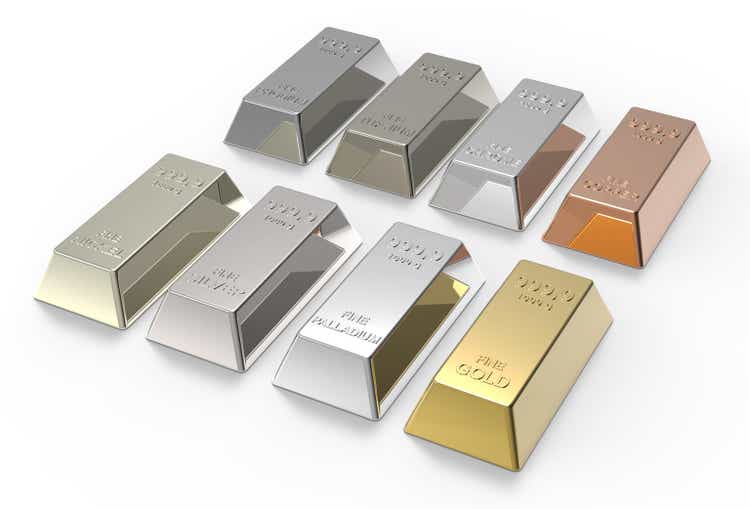[ad_1]
ppart
By Mike Gleason
Happy New Year and welcome to this week’s Market Wrap Podcast, I’m Mike Gleason.
Precious metals markets are finishing out a choppy 2022 on an up note. A strong fourth quarter is pushing both gold and silver prices back up into positive territory for the year.
Gold is up 1.1% this week to trade at $1,828 an ounce. That is now just a couple of dollars higher than where it started the year.
The yellow metal got off to a hot start in 2022, reaching as high as $2,050 an ounce in March. But it suffered a severe pullback in the second and third quarters. A rising U.S. dollar exchange rate amid aggressive Federal Reserve rate hikes drove futures traders to dump precious metals contracts.
In recent weeks, the Federal Reserve note dollar has begun trending lower versus foreign currencies – spurring the gold market to pick up some steam.
Turning to silver, it is slightly outperforming gold for the year. The white metal now shows a very slight weekly gain of 0.2% to bring spot prices to $24.09 an ounce.
The best performing precious metal of 2022 looks to be platinum. Despite years of underperformance that have caused platinum to trade at an historic discount versus gold, prospects for the beaten-down metal may finally be turning around. Platinum is putting in an annual gain of over 10% on the heels of a 3.9% advance this week as prices come in at $1,080. The industrial metal is also closing out Q4 today on the verge of registering its best quarter in nearly 15 years.
The year’s worst performer in the metals space is palladium. Despite surging in the first quarter to a record $3,000 per ounce, the volatile metal is now down about 5% for the year. Palladium is essentially unchanged now for the week to currently trade at $1,821 per ounce, as of this Friday morning recording.
Looking ahead to 2023, there are some good reasons for precious metals bulls to be optimistic. The U.S. Dollar Index appears to have put in a major top. Downside momentum could carry through into next year.
Meanwhile, the Fed has begun to wind down its rate hiking campaign. A recession in 2023 would likely prompt central bankers to fire up more stimulus to try to reinflate the economy and rescue financial markets.
Gold often performs well during recessions. It can certainly be expected to hold up better than economically sensitive stocks and most commodities.
Of course, ongoing inflation pressures should over time lift all hard assets in terms of dollars. Under our monetary regime, cash is destined to depreciate. It’s just a question of by how much. Even if the official inflation rate comes down from its double-digit highs of this year, that doesn’t mean the Fed is somehow succeeding in restoring price stability.
The last thing central bankers want to preside over is a currency with a truly stable value, which would mean 0% inflation and no room for them to maneuver or manipulate. They want to make sure inflation runs at least 2% officially so that debt levels can be steadily inflated away while penalizing and discouraging savers and encouraging spenders.
The risk is that real-world inflation continues to overshoot the Fed’s target. Investors, institutions, and states can protect themselves from inflation uncertainty by adopting sound money policies of their own. The sound money movement made gains in several state houses last year.
In 2022, legislators in 11 states across the U.S. introduced 24 pieces of sound money legislation. These bills seek to eliminate taxation on the sale and purchase of gold and silver, expand and extend existing sales tax exemptions on precious metals, establish in-state gold depositories, and bolster state taxpayer funds with physical gold and silver.
Tennessee became the 42nd state to partially or fully remove sales taxes on gold and silver. Of the 8 states that still impose a sales tax on purchases of precious metals, sound money forces expect sales tax exemption bills to be introduced in Kentucky, Maine, Mississippi, and Wisconsin in the upcoming 2023 legislative season.
Allies in a handful of states are also aiming to eliminate state-level capital gains taxes on sales of precious metals coins and bullion.
Idaho will also consider investing a portion of state funds in physical gold. And Tennessee and Wyoming may do so as well. Wyoming is also considering a system where the state treasurer establishes a mechanism for accepting and remitting payments in gold and silver.
Sound money reforms at the federal level are sorely needed, but for the time being it’s an uphill political battle to try to get any semblance of fiscal or monetary reform enacted. The recent passage of a $1.7 trillion spending bill shows that Washington is determined to keep spending and borrowing. And the Fed will keep accommodating the government’s appetite with new currency creation.
Investors should allocate their assets accordingly as they develop a game plan for 2023.
Well, that will do it for this week and for this year.
Editor’s Note: The summary bullets for this article were chosen by Seeking Alpha editors.
[ad_2]
Image and article originally from seekingalpha.com. Read the original article here.

